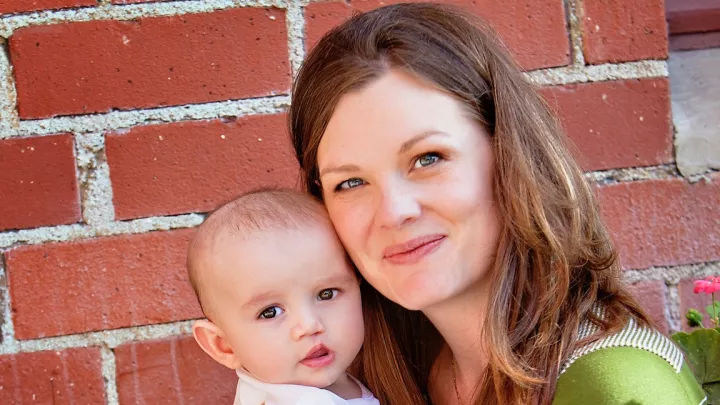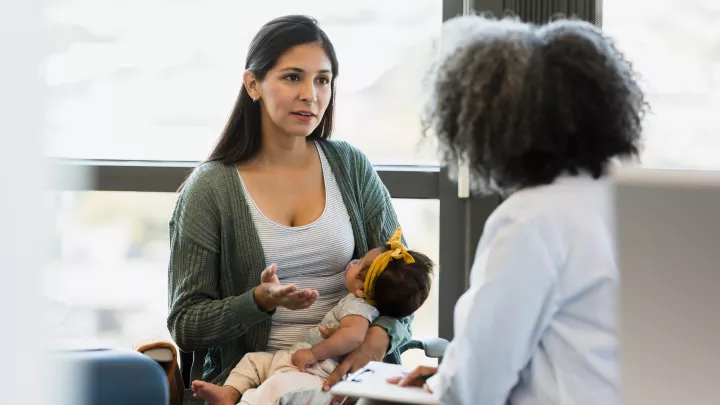Facial Paralysis or Facial Reanimation Surgery
Facial paralysis surgery, or facial reanimation surgery, in children is long and complex. Close attention to detail is important to achieve the best result. Microsurgical connection of nerves and blood vessels ensures survival of the muscle and its subsequent function. Also, accurate muscle positioning and reduction of excessive bulk are equally important.
The specific details of your child’s surgery will be discussed upon initial consultation with the surgeon in the Facial Paralysis Center, but below are some general guidelines.
Surgery for Unilateral Facial Paralysis
Cross-Facial Nerve Graft
The cross-facial nerve graft is designed for children who have unilateral (or one-sided) facial paralysis. A long nerve in the leg, called the sural nerve, is removed. The nerve itself is expendable, producing an inconsequential small patch of sensory loss to the side of the foot. It is used as a nerve graft to transfer impulses from the non-paralyzed to the paralyzed side of the face. The sural nerve is attached to the facial nerve and is then tunneled under the skin of the face to the paralyzed side. A small incision is made in front of the ear, extending slightly along the lower jawline. This allows the surgeon to locate the nerves, attach them to the nerve graft, and place them in the proper position. The final scar is well hidden and has the appearance of a facelift scar. The small incisions on the leg are closed with dissolvable sutures, similar to closure of the facial incision. There may be several small scars or possibly one long scar on the back of the leg below the knee where the sural nerve is harvested.
After Cross-Facial Nerve Graft Surgery
After surgery, children are hospitalized for about three or four days until they are eating and walking normally. Over the next several months, the motor fibers from the functioning facial nerve will grow into the nerve graft. In approximately six to 12 months, sufficient regeneration of the nerve will have occurred, and the child will then be ready for the second stage of the operation, a free functional muscle transplant.
Free Functional Muscle Transplant
In the free functional muscle transplant, a small piece of an inner thigh muscle, called the gracilis muscle, is removed and transferred to the paralyzed side of the face. This muscle is most frequently used for several reasons:
- It has its own separate blood and nerve supply.
- The portion of muscle that is used nicely approximates the force needed to generate an elevation of the corner of the mouth.
- Only a small scar remains along the upper part of the inner thigh, which is easily concealed.
- Taking the muscle from the inner thigh does not result in any functional deficit or difficulty walking.
An incision is made along the front of the ear in the face and extends for a short distance underneath the lower jawline. This allows the surgeon to see the blood vessels and nerves in the face. Great care is taken to position the muscle and anchor it in the area around the corner of the mouth. The blood vessels and nerves of the muscle are connected to the blood vessels and nerves in the face under high-power magnification. The incision on the face mirrors the scar from the cross-facial nerve graft. This is usually well hidden. The incision on the inner thigh is also closed with dissolvable sutures.
After Free Functional Muscle Transplant Surgery
After surgery, children remain in the hospital for about one week. Only soft foods are allowed for about two weeks. It is important that no caffeine be consumed under any circumstance. On discharge, you will be expected to supervise your child’s activity closely at home. No sports activities are allowed for two or three months. Several months are required for the muscle to regain its function. When it does begin to contract on demand from the normal side, it will provide two very important functions. First, by elevating the lower lip and corner of the mouth, the muscle will assist in improving speech. Second, by the same action, the child will be able to generate a smile. The resulting smile will never be perfectly symmetrical, but the improvement will allow for a less noticeable difference. The free functional muscle transplant is by far the most effective procedure currently available for facial paralysis reconstruction.
Surgery for Bilateral Facial Paralysis
Children with bilateral facial paralysis will require the free functional muscle transplant surgery to be performed on each side of the face. There is no need to perform a cross-facial nerve graft. This is because there are no working facial nerves to use. The gracilis muscle from the inner thigh is used. See Surgery for Unilateral Facial Paralysis (above) for a detailed description.
The difference in the application of the free functional muscle transplant for bilateral facial paralysis centers on the nerve supply used to stimulate the muscle. In these cases, the nerve of the muscle is connected to a nerve that supplies one of the muscles used for biting and chewing (the masseteric branch of the trigeminal nerve). Once again, this nerve branch is expendable and results in no discernible effect on chewing.
Questions About Surgery
Day of Surgery
Upon arrival to the hospital, you will be directed to the preoperative area, where you will be checked in by our staff. You will meet the anesthesia team who will perform a physical exam, verify the clinical history and explain the procedure for undergoing general anesthesia. After a final preoperative visit by your surgeon, the nurse will bring your child to the operating room. Depending on the particular surgery being performed, he or she will be in the operating room from four to 10 hours.
After Surgery
After surgery, you will be taken to the recovery room to join your child. A short observation period in the recovery room will be followed by transfer up to your child's hospital room. Expect to be in the hospital for five or more days. Assistance with hotel arrangements may be provided if you are traveling from outside the greater Los Angeles area. Your child will eat and drink a soft diet as soon as he or she wants. Getting out of bed the day after surgery is encouraged, but with plenty of assistance to prevent falls. Medication to minimize pain and discomfort will be provided. Recovery is usually uneventful and proceeds without difficulty.
There may be some swelling and bruising from where the nerves and muscles are removed, but this is usually well treated with pain medication. There will also be swelling and bruising in the face. This will likely persist for two or more weeks. A mouth guard is used to splint the corner of the mouth and protect the transplanted muscle while it heals. This mouth splint will remain in place for 10 days, but can be removed periodically for cleaning and eating purposes. Appointments to see your surgeon will be made following surgery.
Smile Timeline
As early as three months after surgery, children will begin to feel twitching in the new muscle. At this point, facial muscle exercises should be practiced several times each day in front of a mirror.
For children with unilateral facial paralysis who have undergone cross-facial nerve graft followed by a free functional muscle transplant, simultaneous movements on both sides of the face will begin. In this case, the muscle transplant is attached to the working facial nerve in the non-paralyzed side, and a smile is created automatically when the non-paralyzed side activates.
Children who have had the muscle transplant procedure on both sides must learn to activate their new smile by biting down or clenching the teeth together. With practice, children learn to do this easily, although the smile is never completely spontaneous.


